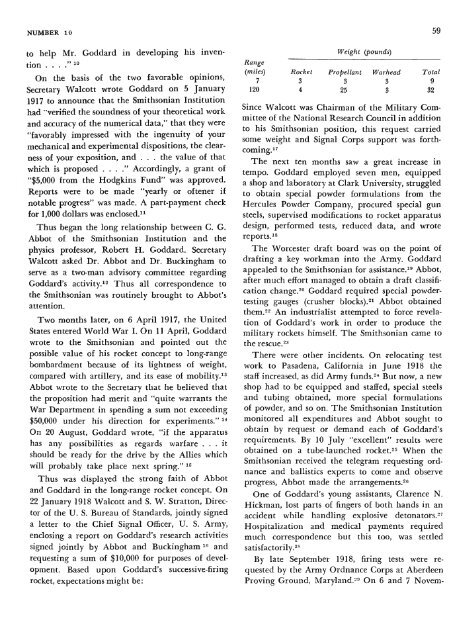FIRST STEPS TOWARD SPACE - Smithsonian Institution Libraries
FIRST STEPS TOWARD SPACE - Smithsonian Institution Libraries
FIRST STEPS TOWARD SPACE - Smithsonian Institution Libraries
Create successful ePaper yourself
Turn your PDF publications into a flip-book with our unique Google optimized e-Paper software.
NUMBER 10<br />
to help Mr. Goddard in developing his invention<br />
. . . ." 10<br />
On the basis of the two favorable opinions,<br />
Secretary Walcott wrote Goddard on 5 January<br />
1917 to announce that the <strong>Smithsonian</strong> <strong>Institution</strong><br />
had "verified the soundness of your theoretical work<br />
and accuracy of the numerical data," that they were<br />
"favorably impressed with the ingenuity of your<br />
mechanical and experimental dispositions, the clearness<br />
of your exposition, and . . . the value of that<br />
which is proposed . . . ." Accordingly, a grant of<br />
"$5,000 from the Hodgkins Fund" was approved.<br />
Reports were to be made "yearly or oftener if<br />
notable progress" was made. A part-payment check<br />
for 1,000 dollars was enclosed. 11<br />
Thus began the long relationship between C. G.<br />
Abbot of the <strong>Smithsonian</strong> <strong>Institution</strong> and the<br />
physics professor, Robert H. Goddard. Secretary<br />
Walcott asked Dr. Abbot and Dr. Buckingham to<br />
serve as a two-man advisory committee regarding<br />
Goddard's activity. 12 Thus all correspondence to<br />
the <strong>Smithsonian</strong> was routinely brought to Abbot's<br />
attention.<br />
Two months later, on 6 April 1917, the United<br />
States entered World War I. On 11 April, Goddard<br />
wrote to the <strong>Smithsonian</strong> and pointed out the<br />
possible value of his rocket concept to long-range<br />
bombardment because of its lightness of weight,<br />
compared with artillery, and its ease of mobility. 13<br />
Abbot wrote to the Secretary that he believed that<br />
the proposition had merit and "quite warrants the<br />
War Department in spending a sum not exceeding<br />
$50,000 under his direction for experiments." 14<br />
On 20 August, Goddard wrote, "if the apparatus<br />
has any possibilities as regards warfare ... it<br />
should be ready for the drive by the Allies which<br />
will probably take place next spring." 15<br />
Thus was displayed the strong faith of Abbot<br />
and Goddard in the long-range rocket concept. On<br />
22 January 1918 Walcott and S. W. Stratton, Director<br />
of the U. S. Bureau of Standards, jointly signed<br />
a letter to the Chief Signal Officer, U. S. Army,<br />
enclosing a report on Goddard's research activities<br />
signed jointly by Abbot and Buckingham 10 and<br />
requesting a sum of $10,000 for purposes of development.<br />
Based upon Goddard's successive-firing<br />
rocket, expectations might be:<br />
Range<br />
(miles)<br />
7<br />
120<br />
Rocket<br />
3<br />
4<br />
Weight (pounds)<br />
Propellant<br />
3<br />
25<br />
Warhead<br />
3<br />
59<br />
Total<br />
9<br />
32<br />
Since Walcott was Chairman of the Military Committee<br />
of the National Research Council in addition<br />
to his <strong>Smithsonian</strong> position, this request carried<br />
some weight and Signal Corps support was forthcoming.<br />
17<br />
The next ten months saw a great increase in<br />
tempo. Goddard employed seven men, equipped<br />
a shop and laboratory at Clark University, struggled<br />
to obtain special powder formulations from the<br />
Hercules Powder Company, procured special gun<br />
steels, supervised modifications to rocket apparatus<br />
design, performed tests, reduced data, and wrote<br />
reports. 18<br />
The Worcester draft board was on the point of<br />
drafting a key workman into the Army. Goddard<br />
appealed to the <strong>Smithsonian</strong> for assistance. 19 Abbot,<br />
after much effort managed to obtain a draft classification<br />
change. 20 Goddard required special powdertesting<br />
gauges (crusher blocks). 21 Abbot obtained<br />
them. 22 An industrialist attempted to force revelation<br />
of Goddard's work in order to produce the<br />
military rockets himself. The <strong>Smithsonian</strong> came to<br />
the rescue. 23<br />
There were other incidents. On relocating test<br />
work to Pasadena, California in June 1918 the<br />
staff increased, as did Army funds. 24 But now, a new<br />
shop had to be equipped and staffed, special steels<br />
and tubing obtained, more special formulations<br />
of powder, and so on. The <strong>Smithsonian</strong> <strong>Institution</strong><br />
monitored all expenditures and Abbot sought to<br />
obtain by request or demand each of Goddard's<br />
requirements. By 10 July "excellent" results were<br />
obtained on a tube-launched rocket. 25 When the<br />
<strong>Smithsonian</strong> received the telegram requesting ordnance<br />
and ballistics experts to come and observe<br />
progress, Abbot made the arrangements. 20<br />
One of Goddard's young assistants, Clarence N.<br />
Hickman, lost parts of fingers of both hands in an<br />
accident while handling explosive detonators. 27<br />
Hospitalization and medical payments required<br />
much correspondence but this too, was settled<br />
satisfactorily. 28<br />
By late September 1918, firing tests were requested<br />
by the Army Ordnance Corps at Aberdeen<br />
Proving Ground, Maryland. 29 On 6 and 7 Novem-

















